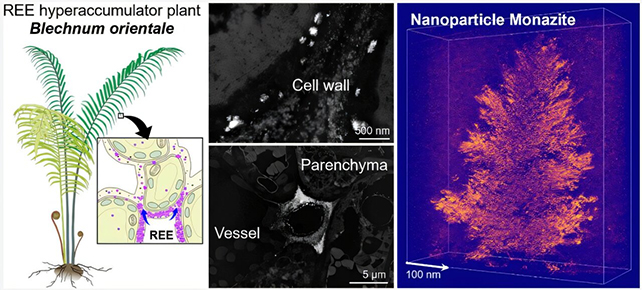Scientists have just discovered an incredible superpower hidden away in the tissues of the fern Blechnum orientale, a plant that can collect and store rare earth elements.
The findings could lead to a more sustainable way of gathering mineral resources that we are increasingly reliant upon.
There are 17 rare earth elements in total, and these metallic materials are now deeply embedded in all kinds of tech – from wind turbines and computers, to broadband cables and medical instruments. They're not actually that rare, but they are difficult and expensive to extract from the Earth's crust in a useful form.
That's where the idea of phytomining comes in, using plants known as hyperaccumulators – capable of growing in richly metallic soils and binding with the metals – to pull mineral resources out of the soil.
Related: Physicists Discover Brand-New Isotopes of Heavy Rare-Earth Elements
"Rare earth elements (REEs) are critical metals for clean energy and high-tech applications, yet their supply faces environmental and geopolitical challenges," Chinese Academy of Sciences geoscientist Liuqing He and colleagues
write in their published paper.
"Phytomining, a green strategy using hyperaccumulator plants to extract metals from soil, offers potential for sustainable REE supply but remains underexplored."

The B. orientale fern was already a known hyperaccumulator, but the scientists discovered something even more special: it was actually growing REE crystals in its tissues.
Via powerful microscopic imaging and chemical analysis, the researchers found the REE-rich compound monazite accumulating as a "chemical garden" inside the plant's own tissues, self-organizing from elements including neodymium, lanthanum, and cerium. It's the first time researchers have seen a plant do this.
Scientists are only just beginning to explore the potential of phytomining, but this study suggests that it may have even more potential than originally thought. At least one plant is forming REE minerals under normal conditions, without the high heat and pressure normally needed under the ground.
"This discovery reveals an alternative pathway for monazite mineralization under remarkably mild conditions and highlights the unique role of plants in initiating such processes," write the researchers.
Further research should help to establish whether this is unique to B. orientale, or whether we can expect to see it in other plants too. There are some signs of it happening in another fern, Dicranopteris linearis, but no direct evidence yet.
Scientists now hope to develop a way of extracting the monazite and breaking it down into its component REEs without losing too much of the resource along the way. There are challenges ahead for sure, but this could transform REE collection – and the many green energy technologies that rely on it.
"This discovery not only sheds light on REE enrichment and sequestration during chemical and biological weathering but also opens new possibilities for the direct recovery of functional REE materials," write the researchers.
"This work substantiates the feasibility of phytomining and introduces an innovative, plant-based approach for sustainable REE resource development."
The research has been published in Environmental Science & Technology.

